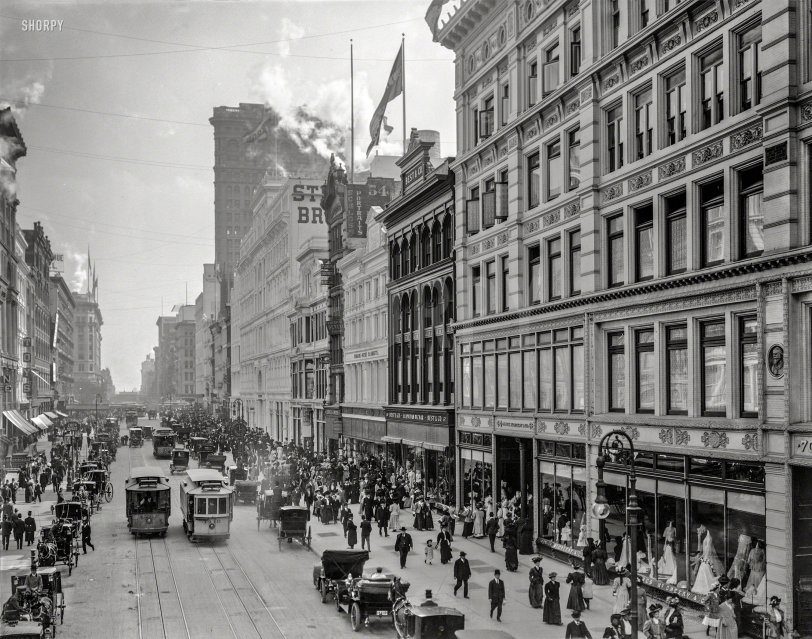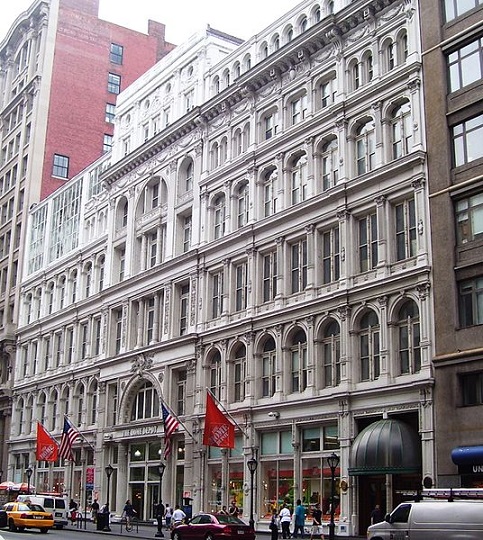


Framed or unframed, desk size to sofa size, printed by us in Arizona and Alabama since 2007. Explore now.
Shorpy is funded by you. Patreon contributors get an ad-free experience.
Learn more.

- Freeze Frame
- Texas Flyer wanted
- Just a Year Too Soon
- WWII -- Replacing men with women at the railroad crossing.
- Yes, Icing
- You kids drive me nuts!
- NOT An Easy Job
- I wonder
- Just add window boxes
- Icing Platform?
- Indiana Harbor Belt abides
- Freezing haze
- Corrections (for those who care)
- C&NW at Nelson
- Fallen Flags
- A dangerous job made worse
- Water Stop
- Passenger trains have right of way over freights?
- Coal
- Never ceases to amaze me.
- Still chuggin' (in model form)
- Great shot
- Westerly Breeze
- For the men, a trapeze
- Tickled
- Sense of loneliness ...
- 2 cents
- Charm City
- What an Outrage
- Brighton Park
Print Emporium
Thronged Thoroughfare: 1908

New York circa 1908. "Twenty-Third Street east from Sixth Avenue." Featured players in this picture include the McCreery dry goods store, Lilliputian Bazaar and our old friend the Flatiron Building. 8x10 glass negative. View full size.
William Shakespeare
The bust Phaedrus asks about is the one and only William Shakespeare. Apparently this building was the site of Booth's Theatre, which opened in 1869 with a production of Romeo and Juliet. When McCreery bought the building, he installed the bust as a tribute. For an in-depth look at the theatre and the fate of the bust see this page at the Performing Arts Archive.
Just the other night
I was in NYC this past weekend and, although it was night-time and snowing and there was no more Sixth Avenue El to take the picture from a raised vantage point, I did dash out into the westbound lanes to do my best (and I ain't no timeandagainphoto) to show you this stretch of 23rd Street two nights ago.
Stern Bros Dept Store
The white 6-story building in the middle of the photo (40 W 23rd Street) was once Stern Bros Dry Goods store. The building has possibly the largest cast-iron facade in Manhattan. Today it houses a Home Depot store.

Whoisit
Wonder who face adorns the building on the far right of the picture?
6th Avenue Elevated Train
To Big Al's question, yes there was a 6th Avenue Elevated Train (until 1940) and this photo appears to have been taken from its 23rd Street station.
Puzzled
Where this photo was taken from? It appears to be at first floor height almost directly over an active tramline. So it's not been taken from inside a building? Was there an elevated railway on 6th?
No Dandelions on a Lawn Russian
Lawn is a specific weight/grade of cotton.
It is still called cotton lawn today, though it is pretty rare that we leave out the fiber name when we have so many synthetic fibers to compete with cotton.
My best guess is the flowing Gibson Girl style dress in question has its buttons down one side of its front, rather than down the middle of the front, in homage to the traditional Cossack style.
Toys and Dentists.
Two things I can't help but think of.
1. Oh boy would I love to walk into that toy store (on the left). Probably find myself a brand new SturdiToy pressed Steel Fire Engine with working ladder. I wish we had a picture of that interior.
2. Those "Dental Parlors." Imagine having a toothache in 1908. The treatment may have been worse than the toothache.
I believe that Shorpy has shown some photos of old dental offices.
Wonder if it is Easter.
Even for 1908, the people on the street are well-dressed. Can you imagine someone from 1908 seeing today's New York, especially in the summer? They'd faint.
Could this scene be part of
the famous NYC Easter Parade? The street crowds seem very well-dressed for just a regular day, and there are so many carriages and liveried coachmen about.
Best Prices
Best & Co. was a top-drawer retailer, with prices to match. They were still around when I was young; they had a store in the Oak Brook Center in the tony western 'burbs of Chicago. I loved when Mom shopped there, as they had a stuffed 3/4 scale horse, with a western-style saddle and covered with real horsehide, for young equestrians to play on. Fabulous diversion, and one that probably escalated the average sales ticket exponentially.
Speaking of prices, I ran both the sale prices on a couple of items in that "Special Sale" ad through an inflation calculator site I frequently use. Get a load of this:
The linen jumpers and "wash suits": "What cost $9.85 in 1908 would cost $255.67 in 2014."
The "Sailor Suits," presumably for boys: "What cost $12 in 1908 would cost $311.47 in 2014."
The regular price on those jumpers? "What cost $29.50 in 1908 would cost $765.71 in 2014."
Mind-boggling.
[Maybe not so mind-boggling when you consider that the average wage in 1908 was 22 cents an hour, as opposed to $24 now. So those $29 jumpers would have taken 131 hours of work to pay for in 1908, as opposed to 32 hours today. (If a pair of jumpers actually cost $765 today, which seems very unlikely!) - Dave]
Photographer's location
I’m trying to figure out where he would have been, so high above the road in the middle of the streetcar track. On top of a streetcar?
Note: Thanks to the suggestion in BigAl42’s comment above (Puzzled), it is now clear to me that the vantage point is the platform of the 23rd Street station of the Sixth Avenue elevated railway. In fact, much further down the street, one can make out the 23rd St. station of the Third Avenue El.
Stern Bros.
The most obvious survivor in this shot is the old Stern Brothers store, what is now Home Depot.
View Larger Map
Small price to pay
For such items as 'Lawn Russian Dresses', whatever they may be. New York Daily Tribune, May 17, 1908.

Early wireless NYC
thanks to the Great Blizzard of 1888 which took down all the overhead wires. It also took down ex Senator Roscoe Conkling, famous womanizer and philanderer, who symbolically overlooks this same 23rd Street in the form of a bronze statue on the nearby southeast corner of Madison Square Park.
The Twenty-third Street Railway went through several gyrations before being replaced by the M23 bus, to the delight of Big Oil/Auto conspiracy theorists.
Best & Company
Later famous for their small, white brick branch stores in the suburbs of NYC and DC. Some remain, though repurposed after McCrory's, which acquired Best in the mid '60s, liquidated the company in 1970. There is presumably no connection between the McCreery's shown here and McCrory's, which also owned Lerner's and S. Kline ("On the Square").
In the 1940s, I had a few outfits my mother purchased for me at the Lilliputian Bazaar, a name that by then had been relegated to a subtitle as the stores' proportion of adult clothing increased. As a kid, I found those ensembles decidedly "sissy" and, like the long and boring church services to which I was forced to wear those togs, just another in an infinite series of adult injustices to be endured.
Pictured here is the chain's original flagship store, established in 1879.
























On Shorpy:
Today’s Top 5